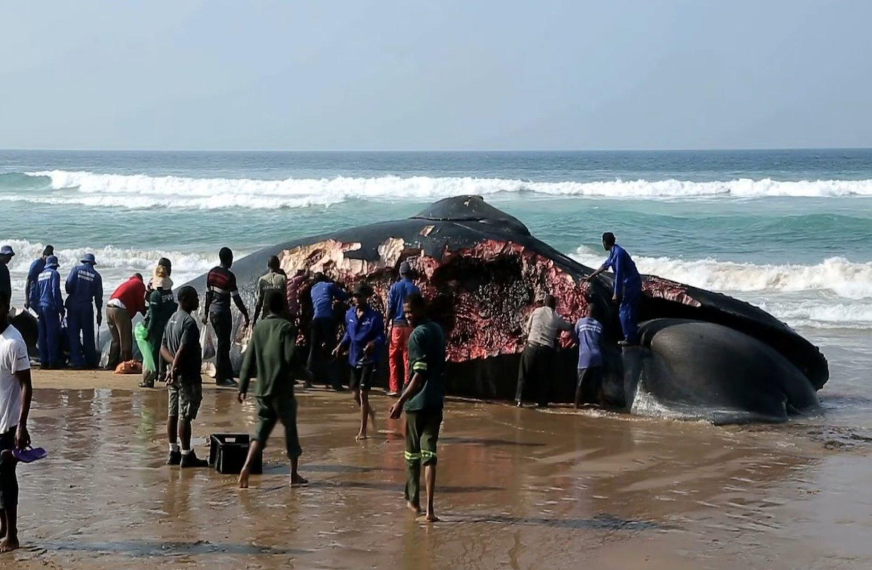Blue Whale South Africa Bitten in Half: Unveiling the Truth

The majestic blue whale, the largest animal on Earth, commands awe and reverence with its sheer size and grace. However, a recent incident off the coast of South Africa has sparked intrigue and concern worldwide. Let’s delve into the circumstances surrounding the “Blue Whale Severed in Half off South Africa, 2021” incident and uncover the truth behind this mysterious occurrence.
Exploring Blue Whales: Familiarity and Lifespan
Blue whales, members of the baleen whale family, are renowned for their colossal size, with adults reaching lengths of up to 100 feet and weights of over 200 tons. These magnificent creatures are characterized by their distinctive blue-gray coloration and baleen plates, which they use to filter krill—their primary food source—from the ocean waters. Despite their immense size, blue whales are gentle giants, known for their peaceful demeanor and solitary nature. With a lifespan of approximately 70-90 years, these marine mammals traverse vast oceanic expanses in search of food and breeding grounds.
Introduction to White Sharks
White sharks, often referred to as great white sharks, are apex predators inhabiting the world’s oceans, including the waters off the coast of South Africa. Recognized for their formidable size, serrated teeth, and powerful jaws, white sharks occupy the upper echelons of the marine food chain, preying on a variety of marine mammals and fish. Despite their fearsome reputation, white sharks play a vital role in maintaining the ecological balance of marine ecosystems.
The Historical Population Trends of Blue Whales
Historically, blue whales have faced significant threats from commercial whaling, leading to a drastic decline in their population numbers. However, concerted conservation efforts and international agreements, such as the International Whaling Commission’s moratorium on commercial whaling, have contributed to the gradual recovery of blue whale populations in some regions. Nonetheless, blue whales remain vulnerable to anthropogenic impacts, including ship strikes, entanglement in fishing gear, and habitat degradation.
The Circumstances Surrounding the “Blue Whale Bitten in Half in South Africa, 2021” Incident
In 2021, reports emerged of a startling discovery off the coast of South Africa—an adult blue whale found severed in half, with the upper portion of its body missing. The incident prompted speculation and concern among marine biologists, conservationists, and the public, with questions arising about the cause of the whale’s demise and the circumstances surrounding its tragic fate.
Was the Blue Whale Incident Widely Circulated?
While initial reports of the blue whale incident garnered attention from local media outlets and marine conservation organizations, the incident did not receive widespread coverage in international news sources. Nonetheless, the discovery of such a rare and dramatic occurrence elicited responses from experts and concerned individuals alike, prompting calls for further investigation and action.
Uncovering the Reality Behind the “Blue Whale Bitten in Half” Case
Subsequent investigations into the blue whale incident revealed evidence suggesting that the whale’s injuries were likely inflicted by a white shark. Analysis of bite marks and forensic examination of tissue samples pointed to the involvement of a large predator, consistent with the feeding behavior of white sharks in the area.
Scrutiny and Investigations into the “Blue Whale Bitten in Half” Incident
Marine biologists and wildlife authorities conducted thorough investigations into the blue whale incident, utilizing forensic techniques and field observations to piece together the events leading to the whale’s demise. Collaborative efforts between scientific institutions, government agencies, and conservation groups aimed to shed light on the incident and inform conservation strategies to mitigate similar occurrences in the future.
Public Response to the News of the Half-Bitten Blue Whale
News of the half-bitten blue whale elicited a mix of emotions from the public, ranging from shock and sadness to fascination and intrigue. The incident served as a poignant reminder of the delicate balance of nature and the complex interactions between marine species in their natural habitats.
Summary
The discovery of a blue whale severed in half off the coast of South Africa in 2021 shed light on the intricate dynamics of marine ecosystems and the vulnerabilities faced by these majestic creatures. While the incident underscored the predatory nature of white sharks and the challenges of coexistence in the marine environment, it also sparked renewed efforts to protect and conserve vulnerable species such as the blue whale.
FAQ
Are blue whales endangered?
Blue whales are classified as endangered species, with population numbers estimated to be a fraction of their historical levels due to past commercial whaling activities and ongoing threats such as ship strikes and entanglement in fishing gear.
What role do white sharks play in marine ecosystems?
White sharks serve as apex predators in marine ecosystems, regulating prey populations and maintaining ecological balance. As keystone species, white sharks play a crucial role in shaping the structure and function of marine food webs.
How do marine biologists investigate incidents involving marine mammals?
Marine biologists employ a variety of techniques, including forensic analysis, necropsies (animal autopsies), and field observations, to investigate incidents involving marine mammals such as blue whales. These investigations aim to determine the cause of death, identify contributing factors, and inform conservation measures.
What conservation measures are in place to protect blue whales?
Conservation measures to protect blue whales include international agreements such as the International Whaling Commission’s moratorium on commercial whaling, marine protected areas, regulations to reduce ship strikes and fishing gear entanglement, and public awareness and education initiatives.
How can individuals contribute to the conservation of marine species?
Individuals can support marine conservation efforts by advocating for sustainable fishing practices, reducing plastic pollution, supporting marine protected areas, participating in citizen science initiatives, and raising awareness about the importance of preserving marine biodiversity.



